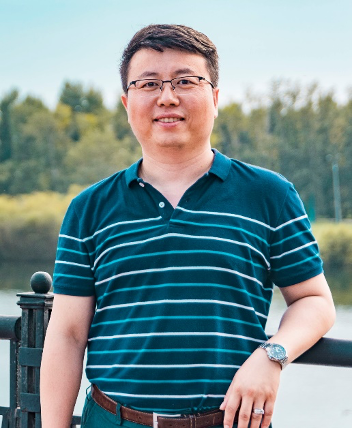Duan Feng

Name: Duan Feng
Gender: male
Department: Department of Automation and Intelligent Science
Administrative position:
Title: Professor
Education: Doctor
Major: Precision machinery
Office tel: 022-85358718
Email: duanf@nankai.edu.cn
Research interests: Robot technology, Myoelectric Prosthetic Hand, Rehabilitation Robot, Robot Vision, Home Service Robot, Human Skills Analysis
[Education and Work Experience]
PROFESSIONAL POSITIONS
12/2016-Present: Professor
College of Artificial Intelligence, Nankai University
03/2010-11/2016: Associate Professor
College of Computer and Control Engineer, Nankai University
EDUCATION
10/2006-09/2009: The University of Tokyo
Doctor of Precision Mechanical Engineering
10/2004-09/2006: The University of Tokyo
Master of Precision Mechanical Engineering
09/2002-07/2004: Tianjin University
Master of Power Machinery and Engineering
09/1998-07/2002: Tianjin University
Bachelor of Power Machinery and Engineering
Individual resume
Duan Feng graduated from The University of Tokyo with PhD degree. Currently, he is a professor at the College of Artificial Intelligence, Nankai University, and his research interests include brain science and artificial intelligent robot. He has published 165 academic papers, including many top journals such as TIE and TNSRE, and the papers have been cited for more than 1000 times. He has presided over 36 projects, including Key projects of NSFC, Science Foundation for Outstanding Youth of Tianjin. In terms of brain science research, he has developed brain-controlled vehicle and brain-controlled rat, and the results have been reported in Nature. In terms of robot research, he has made omnidirectional mobile exoskeleton-assisted robot, epidemic prevention teleportation robot, waterproof myoelectric prosthetic hand, and man-machine inclusive flexible production line etc. He has obtained the Special Contribution Award of the Japanese Society of Artificial Intelligence, the Champion of RoboCup Japan Open (3 Times), the Second Prize of Tianjin Science and Technology Progress (3 Times), the Golden Bridge Award of the China Technology Market Association, Malaysia Best Industrial Service Paper Award etc. He also obtained the Tianjin Natural Science Foundation for Distinguished Young Scholars, and the First Level Talent of Tianjin 131.
[Projects,Award and Patent]
Mainly research projects:
1. Research on Key Technology and Applications of Omni-directional Mobile Exoskeleton Robot, National Key Research and Development Program
2. The Effects of Non-invasive Deep Brain Stimulation on the Improving Human Performance and its Mechanisms, Key projects of National Natural Science Foundation of China
3. Research on Coordination Control System of Walking Assistant Robot Based on Human Motion Awareness and Motion Characteristics, National Natural Science Foundation of China General Program
4. Research on Coordination Control of Walking Assisted Robot and Elderly People Based on Cognitive Model, National Natural Science Foundation of China Youth Science Foundation Project
5. Coordination Control System of Walking Rehabilitation Robot Based on Human Motion Awareness and Functional Characteristics, Tianjin Outstanding Youth Science Foundation
6. Development of Intelligent EMG Artificial Hand and Industrialized Application, Tianjin Supportive Plan
7. Technology Development and Integrated Application of Rehabilitation Robot for the Aged Based on Mobiligence, Tianjin International Cooperation Project
Main Awards:
1. The second prize of Tianjin Advanced science and technology (Project Name: Key technologies for the smart prosthetic hand based on sEMG, Rank 1), 2020
2. The second prize of Tianjin Advanced science and technology (Project Name: Research and application of key techniques of nerve scaffold combined with biomimetic mechanics to promote regeneration and repair of spinal cord injury, Rank 2), 2020
3. The second prize of Tianjin Advanced science and technology (Project Name: The Industrialization of an Omnidirectional Mobile Power Assistant Robot based on the Admittance Control Technology, Rank 1), 2018
4. “Advanced Individual of JinQiao Award” in Chinese technical market, 2018
5. “Young pioneers in scientific and technological innovation” in Tianjin technical market association, 2018
6. RoboCup Japan Open @Home 2017 Competition Education Team Championship, 2017
7. ICME International Conference on Complex Medical Engineering Robot Service of Best paper Award,2017
8. Rob Cup Japan Open @Home 2016 Competition Simulation Team Championship.2016
9. The Championship (only one championship in China) in the 6th “Huawei Cup” of Chinese College Students Competition Intelligent Design, 2016
10. RoboCup Japan Open @Home 2015 Competition SPL Team Championship,2015
[Publications and Books]
[2] Feng Duan, Lili Dai, “Recognizing the Gradual Changes in sEMG Characteristics Based on Incremental Learning of Wavelet Neural Network Ensemble,” IEEE Transactions on Industrial Electronics, vol. 64, no. 5, pp. 4276-4286, 2017.
[3] Feng Duan*, Lili Dai, Wennan Chang, Zengqiang Chen, Chi Zhu*, Wei Li, “sEMG-Based Identification of Hand Motion Commands Using Wavelet Neural Network Combined with Discrete Wavelet Transform,” IEEE Transactions on Industrial Electronics, vol. 63, no. 3, pp. 1923-1934, 2016.
[4] Feng Duan1*, Zihao Huang1, Zhe Sun*, Yu Zhang, Qibin Zhao, Andrzej Cichocki, Zhenglu Yang, Jordi Solé-Casals*, “Topological Network Analysis of Early Alzheimer’s Disease Based on Resting-State EEG,” IEEE Transactions on Neural Systems and Rehabilitation Engineering, vol. 28, no. 10, pp. 2164-2172, DOI: 10.1109/TNSRE.2020.3014951, 2020.
[5] Feng Duan*, Jianing Xue, Zhe Sun, Xuyi Chen, Yu Liu, and Hiroshi Yokoi, “A Novel Waterproof sEMG Electrode Based on Conductive Silicone for Underwater Signal Recognition,” IEEE Sensors Journal, vol. 21, no. 18, pp. 20388-20397, September 15, 2021. DOI: 10.1109/JSEN.2021.3095118.
[6] Binghua Li1, Zhiwen Zhang1, Feng Duan*, Zhenglu Yang, Qibin Zhao, Zhe Sun*, Jordi Solé-Casals*, “Component-mixing Strategy: A Decomposition-based Data Augmentation Algorithm for Motor Imagery Signals,” Neurocomputing, vol. 465, no. 2021, pp. 325–335, 2021.
[7] Feng Duan*, Hao Jia, Zhe Sun*, Kai Zhang, Yangyang Dai, Yu Zhang, “Decoding Premovement Patterns with Task Related Component Analysis,” Cognitive Computation, vol. 13, no. 5, pp. 1389-1405, 2021, DOI: 10.1007/s12559-021-09941-7.
[8] Jin Zhang1, Fan Feng1, Tianyi Han, Feng Duan*, Zhe Sun*, Cesar F. Caiafa, Jordi Solé-Casals*, “A Hybrid Method to Select Morphometric Features Using Tensor Completion and F-Score Rank for Gifted Children Identification,” Science China-Technological Sciences, vol. 64, no. 9, pp. 1863-1871, SEP 2021, DOI: 10.1007/s11431-020-1876-3.
[9] Feng Duan*, Hao Jia, Zhiwen Zhang, Fan Feng, Ying Tan, Yangyang Dai, Andrzej Cichocki, Zhenglu Yang, Cesar F. Caiafa*, Zhe Sun*, and Jordi Sol´e-Casals*, “On the Robustness of EEG Tensor Completion Methods,” Science China-Technological Sciences, vol. 64, no. 9, pp. 1828-1842, SEP 2021, DOI: 10.1007/s11431-020-1839-5.
[10] Mingxin Zhang, Feng Duan*, Shan Wang, Kai Zhang, Xuyi Chen, Zhe Sun, “A Study of the Brain Network Connectivity in Visual-Word Pairing Associative Learning and Episodic Memory Reactivating Task,” Computational Intelligence and Neuroscience, vol. 2021, Article ID 5579888, 13 pages, 2021.
[11] Shan Wang, Feng Duan*, Mingxin Zhang, “Convolution-GRU Based on Independent Component Analysis for fMRI Analysis with Small and Imbalanced Samples,” Applied Sciences-Basel, vol. 10, no. 21, DOI: 10.3390/app10217465, 2020.
[12] Tianlei Jin, Feng Duan*, Zhenyu Yang, Shifan Yin, Xuyi Chen, Yu Liu, Qingyu Yao and Fengzeng Jian, “Markerless Rat Behavior Quantification with Cascade Neural Network”, Frontiers in Neurorobotics, vol. 14, DOI: 10.3389/fnbot.2020.570313, 2020.
[13] Zhe Sun, Zihao Huang, Feng Duan*, Yu Liu, “A Novel Multimodal Approach for Hybrid Brain–Computer Interface,” IEEE Access, vol. 8, no. 1, pp. 89909-89918, DOI: 10.1109/ACCESS.2020.2994226, 2020.
[14] Yikang Yang, Feng Duan*, Jia Ren, Jianing Xue, Yizhi Lv, Chi Zhu, Hiroshi Yokoi, “Performance Comparison of Gestures Recognition System Based on Different Classifiers,” IEEE Transactions on Cognitive and Developmental Systems, vol. 13, no. 1, pp. 141-150, March 2021, DOI: 10.1109/TCDS.2020.2969297.
[15] Feng Duan*, Xina Ren, Yikang Yang, “A Gesture Recognition System Based on Time Domain Features and Linear Discriminant Analysis,” IEEE Transactions on Cognitive and Developmental Systems, vol. 13, no. 1, pp. 200-208, March 2021, DOI: 10.1109/TCDS.2018.2884942.
[Courses]
Undergraduate professional Courses:
“Fundamentals of Motor and Dyive”
“Robot Software Engineering”
[Memberships]
[1] Vice Group Director on Brain Injury and Neural Repair in the first Professional Committee on Neurogenesis and Neurorestoratology of the Chinese Society of Research Hospitals
[2] Director of Tianjin Technology Market Association
[3] Visiting Professor, The University of Electro-Communications, Japan
[4] Visiting Professor, Maebashi Institute of Technology, Japan
[5] Member of Chinese Society of Artificial Intelligence





